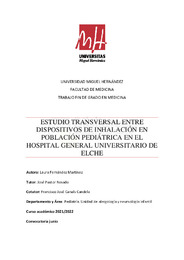Please use this identifier to cite or link to this item:
https://hdl.handle.net/11000/28508Estudio transversal entre dispositivos de inhalación en población pediátrica en el Hospital General Universitario de Elche
| Title: Estudio transversal entre dispositivos de inhalación en población pediátrica en el Hospital General Universitario de Elche |
| Authors: Fernández Martínez, Laura |
| Tutor: Pastor Rosado, Jose Canals Candela, Francisco José |
| Editor: Universidad Miguel Hernández de Elche |
| Department: Departamentos de la UMH::Farmacología, Pediatría y Química Orgánica |
| Issue Date: 2022-05-17 |
| URI: https://hdl.handle.net/11000/28508 |
| Abstract: INTRODUCCIÓN El asma es una de las enfermedades crónicas más prevalentes en la infancia, afectando alrededor de 1 de cada 10 niños en España y provocando una merma importante en la calidad de vida y un elevado coste económico. Un aspecto esencial para el manejo es la educación del niño asmático y su familia, que incluye verificar la adherencia al tratamiento y el correcto uso de los inhaladores. En este estudio se pretende comparar el grado de satisfacción mediante cuestionario, entre pacientes usuarios de dispositivos de polvo seco y pacientes usuarios de dispositivos de cartucho presurizado, en pacientes pediátricos con similar estadío de asma. MATERIAL Y MÉTODOS Se realiza un estudio transversal en pacientes asmáticos pediátricos con similar estadío de la enfermedad, en el que se analizan características sociodemográficas, presencia de antecedentes familiares de asma o alergia, tipo de dispositivo de inhalación utilizado, asociación de otras enfermedades de interés, aspectos relacionados al control de su asma y a su dispositivo de inhalación, recogidos mediante un cuestionario tipo CAN y FSI-10. RESULTADOS De los 30 pacientes, se analizaron 29 (excluyendo 1 por pérdida de cuestionario), 72% hombres, 8±7 años, 72% antecedentes familiares de primer grado, 7% antecedentes familiares de segundo grado, 17% fumadores pasivos, 69% usuarios de inhaladores MDI, 31% usuarios de inhaladores de polvo seco. Además, estos presentaron comorbilidad asociada, con una o más patologías: rinitis alérgica 66%, dermatitis atópica 22%, asma bronquial 11%, alergia a proteínas de leche de vaca 11%, alergia a antiinflamatorios no esteroideos 11%, prematuridad 11%, covid-19 reciente 11%. En relación al control de su asma en las últimas 4 semanas, comparando MDI versus polvo seco: tos diurna 1.05±0.49vs1.67±1.22, p>0.05; tos nocturna 1.15±0.44vs1.44±1.28, p>0.05; sibilancias diurnas 0.40±0.24vs1.00±0.86, p>0.05; sibilancias nocturnas 0.65±0.41vs0.89±0.90, p>0.05; dificultad respiratoria diurna 0.65±0.41vs1.33±1.01, p>0.05; dificultad respiratoria nocturna 0.80±0.42vs1.11±1.05, p>0.05; tos o silbidos ante ejercicio físico o risa a carcajadas 1.55±0.63vs2.11±0.90, p>0.05; visitas a urgencias 0.15±0.17vs0, p>0.05; no se registraron ingresos hospitalarios. En cuanto al dispositivo de inhalación utilizado, comparando MDI versus polvo seco: facilidad de aprendizaje 1.25±0.34vs1.56±0.68, p>0.05; facilidad de utilización 1.20±0.29vs1.44±0.86, p>0.05; comodidad en el transporte 1.40±0.47vs0.67±077, p>0.05; grado de satisfacción 1.35±0.41vs1.33±1.08 p>0.05. Tras estratificar la muestra en >6 años, se obtuvieron 19 pacientes, 10 usuarios MDI y 9 usuarios polvo seco. CONCLUSIONES No se han encontrado diferencias en cuanto al grado de satisfacción, el control de asma y las características de los pacientes al comparar los usuarios de MDI y los usuarios de dispositivo de polvo seco. INTRODUCTION Asthma is one of the most prevalent chronic diseases in childhood, it appears in around 1 to 10 children in Spain and causes significant decrease in quality of life and a high economic cost. An essential aspect for management is the education of the asthmatic child and his family, which includes verifying adherence to treatment and the correct use of inhalers. This study aims to compare the degree of satisfaction by means of a questionnaire, between patients who use dry powder devices and patients who use pressurized cartridge devices, in pediatric patients with a similar stage of asthma. MATERIAL AND METHODS A cross-sectional study is carried out in pediatric asthmatic patients with a similar stage of the disease, in which sociodemographic characteristics, presence of family history of asthma or allergy, type of inhalation device used, association of other diseases of interest, aspects related to control of their asthma and their inhalation device, collected through a questionnaire type CAN and FSI-10. RESULTS Of the 30 patients, 29 were analysed (excluding 1 due to missing questionnaire), 72% men, 8±7 years old, 72% first-degree family history, 7% second-degree family history, 17% passive smokers, 69% users of MDI inhalers, 31% users of dry powder inhalers. In addition, they presented associated comorbidity, with one or more pathologies: allergic rhinitis 66%, atopic dermatitis 22%, bronchial asthma 11%, allergy to cow's milk proteins 11%, allergy to non-steroidal anti-inflammatory drugs 11%, prematurity 11%, recent covid-19 11%. Regarding the control of their asthma in the last 4 weeks, comparing MDI versus dry powder: daytime cough 1.05±0.49vs1.67±1.22, p>0.05; nocturnal cough 1.15±0.44vs 1.44±1.28, p>0.05; daytime wheezing 0.40±0.24 vs 1.00±0.86, p>0.05; nocturnal wheezing 0.65±0.41 vs 0.89±0.90, p>0.05; daytime respiratory distress 0.65±0.41 vs 1.33±1.01, p>0.05; nocturnal respiratory distress 0.80±0.42vs 1.11±1.05, p>0.05; coughing or whistling before physical exercise or laughing out loud 1.55±0.63vs2.11±0.90, p>0.05; emergency room visits 0.15±0.17vs0, p>0.05; no hospital admissions were recorded. Regarding the inhalation device used, comparing MDI versus dry powder: ease of learning 1.25±0.34vs1.56±0.68, p>0.05; ease of use 1.20±0.29vs1.44±0.86, p>0.05; transportation comfort 1.40±0.47vs0.67±077, p>0.05; degree of satisfaction 1.35±0.41vs1.33±1.08 p>0.05. After stratifying the sample in >6 years, 19 patients were obtained, 10 MDI users and 9 dry powder users. CONCLUSIONS No differences were found in terms of satisfaction, asthma control, and patient characteristics when comparing MDI users and dry powder device users. |
| Keywords/Subjects: Asma infantil Dispositivos de inhalación MDI Polvo seco Satisfacción |
| Knowledge area: CDU: Ciencias aplicadas: Medicina |
| Type of document: info:eu-repo/semantics/bachelorThesis |
| Access rights: info:eu-repo/semantics/openAccess |
| Appears in Collections: TFG- Medicina |
.png)

